1 - 60 of 319 records
Joan of Arc saved France
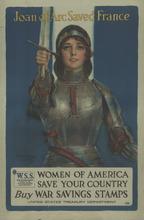
Description: "This World War I poster, issued by the United States Department of the Treasury, urges women to buy war savings stamps to help finance the war effort. The War Savings Stamps (W.S.S.) program aimed to instill patriotism in citizens as well as raise funds. Stamps were available in 10-cent and 25-cent versions, and were bought by school-age children and other small savers. This poster invokes the figure of Joan of Arc (circa 1412–31), the traditionally recognized patriot and martyr of France who led the fight against the English in the Hundred Years' War. The illustration of a beautiful young Joan, raising her sword, is by Haskell Coffin (1878–1941), an American artist best known for his portrayals of women on the covers of The Saturday Evening Post, McCall's Magazine, The American Magazine, Redbook, and other weekly and monthly magazines"--World Digital Library.
Member of: World War I Posters (Collection)
Resource Type: Still Image
U.S. Marines
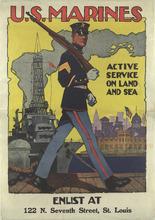
Description: MU: Rest of poster reads: Enlist at 122 N. Seventh Street, St. Louis mounted on canvas.,Poster showing Marine in dress blues marching in front of ship.
Member of: World War I Posters (Collection)
Resource Type: Still Image
Department of Transportation
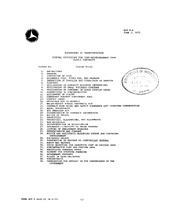
Description: "DOT P-4, June 2, 1972 ; FORM DOT F 4220.20 (6-2-72).",Scanned with Zeutschel OS 15000 scanner using Omniscan scanning software at 600 dpi, grayscale. Images saved as tiff files with LZW compression. Images were cropped, resized, and brightened.
Member of: Works Projects Administration Historical Records Survey
Resource Type: Text
For active service, join the U.S. Marines
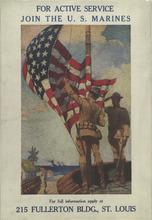
Description: For full information apply at 215 Fullerton Bldg., St. Louis.,MU: Poster mounted on canvas (010-509224830),Poster showing two Marines raising flag with battleships and formation of Marines in background.
Member of: World War I Posters (Collection)
Resource Type: Still Image
Transition Assistance Program
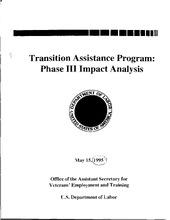
Member of: Works Projects Administration Historical Records Survey
Resource Type: Text
A Stitch in time: 4th Liberty Loan
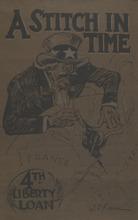
Description: Poster showing Uncle Sam stitching countries of Europe together.
Resource Type: Still Image
Avenge December 7
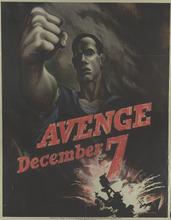
Description: Poster showing, in a somber graphic design, a sailor clenching his fist looming above the image of a sinking naval ship.
Member of: World War I Posters (Collection)
Resource Type: Still Image
Free war exhibit
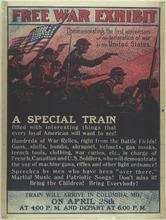
Description: Poster showing soldiers shooting at unseen enemy.,Rest of text reads: A special train filled with interesting things that every loyal American will want to see! Hundreds of war relics, right from the battle fields! Guns, shells, bombs, shrapnel, helmets, gas masks, trench tools ... Speeches by men who have been over there. Martial music and patriotic songs! Don't miss it! Bring the children! Bring everybody! Train will arrive in Columbia, Mo. on April 28th at 4:00 p.m. and depart at 6:00 p.m.
Member of: World War I Posters (Collection)
Resource Type: Still Image
Official notice
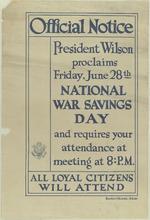
Description: Text only poster printed in blue ink with image of the Great Seal of the United States at left.
Resource Type: Still Image
U. S. Marines, the soldiers of the sea
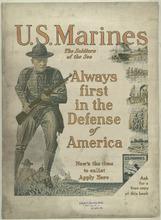
Description: Poster showing Marines fighting on the left and various scenes of Marine activities on the right.,Right bottom corner reads: Ask for a free copy of this book.,MU: Poster stamped at bottom: U. S. Marine Recruiting Station, 306 College Street, Springfield, Mo.,MU: Poster mounted on canvas.
Member of: World War I Posters (Collection)
Resource Type: Still Image
Family enrollment week, Oct. 28th to Nov. 4th
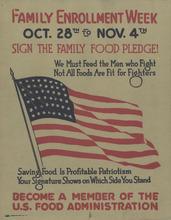
Description: Poster showing American flag in center asking people to sign the family food pledge.
Resource Type: Still Image
Veterans of the big war
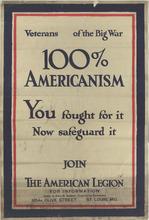
Description: Text in blue with red and blue borders.,Join the American Legion.,MU: Poster mounted on canvas.,MU: University of Missouri Library stamp, Oct 30 1947 on verso.,For more information, apply to John S. Seibert, Organizing Secretary, 1214a Olive Street, St. Louis, MO.
Member of: World War I Posters (Collection)
Resource Type: Still Image
Veterans of the big war, we have stood together, let's stick together
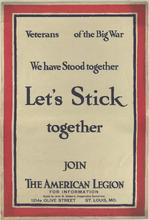
Description: For information apply to John S. Seibert, organizing secretary, 1214a Olive Street, St. Louis, Mo.,MU: Poster mounted on canvas.
Member of: World War I Posters (Collection)
Resource Type: Still Image
Boys and girls!
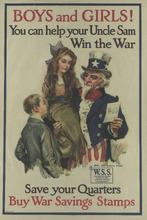
Description: Poster showing Uncle Sam with a girl and boy.
Resource Type: Still Image
Lest we perish
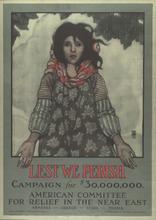
Description: Poster showing Near Eastern girl with arms outstretched.
Member of: World War I Posters (Collection)
Resource Type: Still Image
Exhibit of American Federation of Labor
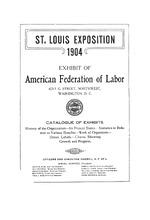
Description: Catalogue of exhibits -- History of the organization -- Its present status -- Statistics in relation to various benefits -- Work of organizers -- Union labels -- Charts showing growth and progress.,Title from NUC pre-1956 imprints.,At head of title: St. Louis Exposition, 1904.
Member of: Louisiana Purchase Exposition: The 1904 St. Louis World's Fair (Collection)
Resource Type: Text
Second patriotic food show.
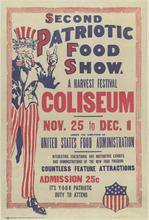
Description: Poster in red, white and blue showing Uncle Sam standing on left pointing to text.
Resource Type: Still Image
Colored map of Louisiana Purchase territory and all acquisitions
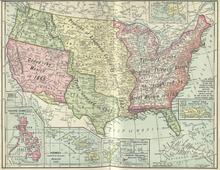
Description: Shows the territory of the original 13 states and United States land acquisitions and annexations including Louisiana Purchase, Florida, Alaska, Texas, Hawaii, the southwestern United States, the Gadsden Purchase, the establishment of the settlement line with Great Britain of the Oregon Territory, and other islands.
Member of: Miscellaneous Maps (Collection)
Resource Type: cartographic
Map of the United States, constructed from the latest authorities, 1826
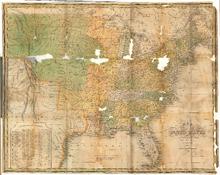
Description: Folded in leather cover.,Scale: ca. 1:730,000.,"The publisher is indebted to the politeness of Major S. H. Long for the use of his documents in the construction of that portion of this map west of the Mississippi River.","J. H. Young S..." (Border damaged; balance of word wanting),Map drawn by David H. Vance.
Member of: Miscellaneous Maps (Collection)
Resource Type: cartographic
America : Being the latest, and most accurate description of the New World : [pages 277-278]

Description: Leaf (pages 277-278) from an early travel book on the Americas originally published by John Ogilby, 1671. Parts of text based on Arnoldus Montanus's "De Nieuwe en onbekende weereld: of beschryving van America en't zuid-land." Engraving top of page 277 illustrates a description of the "Inhabitants of Mexico." "…Cloth'd in Cotton: On their heads they wore a high Plume of red Feathers; about their Necks, over their Shoulders, Breast and Back, a kind of large Thorax of Feathers curiously pleited ; each Arm adorn'd with Armlets, and their Middles girt with broad white Girdles full of red Streaks ; in stead of Garters they wore Laces of Feathers, as also a little above their Ancles."
Member of: Pages from the past - all pages
Resource Type: Text
Moral reflection
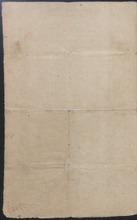
Description: Original manuscript : 31 x 19 cm,Original was inserted in back of Lucubrator.,Holograph.
Member of: Lucubrator (Collection)
Resource Type: Text
Domestic slavery considered as a Scriptural institution
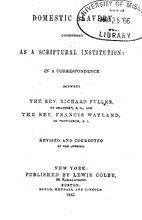
Member of: All Books and Texts
Resource Type: Text
The Territorial papers of the United States, Volume 15. The territory of Louisiana-Missouri, 1815-1821. The Territory of Louisiana-Missouri, 1803-1821,Territory of Louisiana-Missouri, 1802-1821

Description: [v. 1]. 1803-1806 -- [v. 2]. 1806-1814 -- [v. 3] 1815-1821.,Issued by the Dept. of State as its Publication no. 3096, 3502; National Archives Publication 51-9.,Includes bibliographical references and indexes.
Member of: Territorial papers of the United States (Multi-volume set)
Resource Type: Text
The Territorial papers of the United States, Volume 14. The territory of Louisiana-Missouri, 1806-1814,Territory of Louisiana-Missouri, 1802-1821
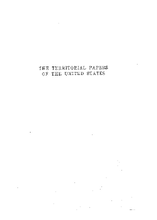
Description: Issued by the Dept. of State as its Publication no. 3096, 3502; National Archives Publication 51-9.,Includes bibliographical references and indexes.,LSO ID: umlc000005.
Member of: Territorial papers of the United States (Multi-volume set)
Resource Type: Text
Boone Stop
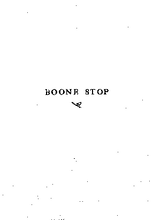
Description: LSO ID: umlc000038.
Member of: Missouriana: All Volumes (Collection)
Resource Type: Text
Contemporary American conception of equality among men as a social and political ideal

Description: At head of title: University of Missouri, Phi beta kappa.
Member of: All Books and Texts
Resource Type: Text
A Full description of the soil, water, timber, and prairies of each lot, or quarter section of the military lands between the Mississippi and Illinois rivers
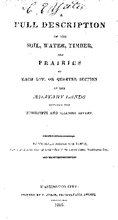
Description: LSO ID: umlk000015.
Member of: Missouriana: Geology (Collection)
Resource Type: Text
JM-192: Nope!
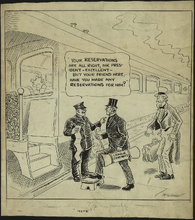
Description: This cartoon shows President Woodrow Wilson boarding a train. Uncle Sam is attempting to also board the train, but it seems he does not have a reservation. The bag President Wilson is carrying is titled, "League Covenant". This bag most likely refers to President Wilson's ambition to form the League of Nations, an collection of nations working together to create international unity. The League of Nations existed from 1920 to 1946. The United States never officially joined the League of Nations, because congress feared its membership would limit the United States' national sovereignty. At the time, many Americans suggested joining the League of Nations would not benefit the United States. However, there was also a population of Americans, including Woodrow Wilson, who believed The League of Nations' efforts towards international peace would offer great benefits to the United States. (Summary created by Mary Delano, MU History Intern, Spring 2018)
Member of: McCutcheon Editorial Cartoons - ALL (Collection)
Resource Type: Still Image
JM-179: There are some Congressmen who don't want the Germans to see we are in earnest
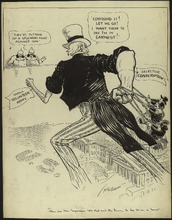
Description: This cartoon depicts Uncle Sam being held back by by men from fighting with his full strength. Uncle Sam is meant to personify the United States. Uncles Sam's weak arm represents the feeble military forces available through voluntary enlistment. Uncle Sam's bulky arm represents the United States's powerful military capability if it enacted the draft. The group holding back Uncle Sam is representative of congress. The two Germans represent Germany across the Atlantic. This comic is showing the disagreement in the United States of employing conscription during World War I. The United States fought in World War I from 1916 to 1918. The draft was eventually employed on May 18, 1917 until November 11, 1919 through the Selective Service Act of 1917. (Summary created by Mary Delano, MU History Intern, Spring 2018)
Member of: McCutcheon Editorial Cartoons - ALL (Collection)
Resource Type: Still Image
History of the First and Second Missouri Confederate brigades, 1861-1865; and, From Wakarusa to Appomattox, a military anagraph
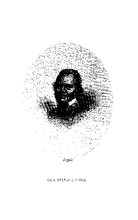
Description: Reprint. Originally published: St. Louis: Bryan, Brand, 1879.
Member of: All Books and Texts
Resource Type: Text
The Negroes of Columbia, Missouri: a concrete study of the race problem
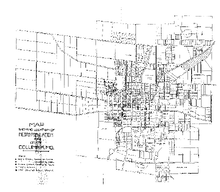
Description: LSO ID: umlc000007.,M.A. University of Missouri 1902.
Member of: Missouriana: History (Collection)
Resource Type: Text
Journal of a tour into the interior of Missouri and Arkansaw
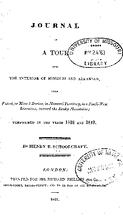
Description: Contains Transallegania, or The groans of Missouri : a poem / by H.R. Schoolcraft (p.[92]-102).,8vo: B-N4 O4( -O4).,LSO ID: umlc000013.,Original issued with: "Voyage from France to Cochin-China in the ship Henry / [by] Captain Rey, of Bordeaux, in the years 1819 and 1820": p. [103]-128.
Member of: Missouriana: History (Collection)
Resource Type: Text
Reminiscences of Company "H", First Arkansas Mounted Rifles

Description: LSO ID: umlr000066.nLSO ID: civr000066.nOCLC/WorldCat number: 5140373.
Member of: Missouriana: History (Collection)
Resource Type: Text
Letter of transmittal from the United States Treasury Department to the University of Missouri, May 18, 1912
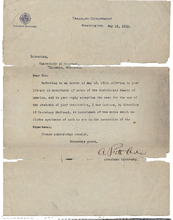
Description: Letter which accompanied the gift of Confederate Currency from the United States Treasury Department to the University of Missouri. The letter is dated May 18, 1912 and is signed by the Assistant Secretary of the Treasury, A. Piatt Andrew.
Member of: Confederate Currency enclosures
Resource Type: Text
JM-159: The value of ideals
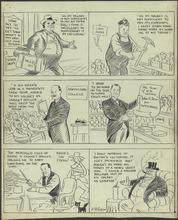
Description: Editorial cartoon depicting William Jennings Bryan lecturing to earn money in the aftermath of his loss in the 1900 senatorial election. Bryan charged $500 per speech or lecture, and he was the most popular speaker on the Chautauqua circuit from 1900 to 1912.
Member of: McCutcheon Editorial Cartoons - ALL (Collection)
Resource Type: Still Image
JM-190: America would like to know
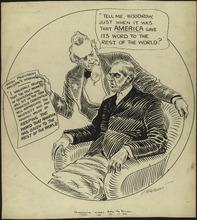
Description: Editorial cartoon depicting Uncle Sam questioning President Wilson about when "America gave its word to the rest of the world" while holding a paper containing a quotation from part of Wilson's interview.
Member of: McCutcheon Editorial Cartoons - ALL (Collection)
Resource Type: Still Image
JM-148: Japan objects to the weapon which he himself has never hesitated to use
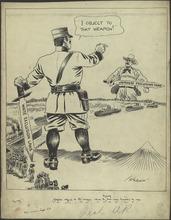
Description: This cartoon personifies United States relations with Japan in 1913. Japan is criticizing California for employing Japanese exclusion laws. These laws are most likely a reference to the California Alien Land Law of 1913. This law prohibited "aliens ineligible for citizenship" from owning agricultural land or possessing long-term leases, but permitted short-term leases lasting up to three years. This act was problematic for diplomatic relations with Japan, as it directly discriminated against Japanese citizens. This law also limited the number of Japanese immigrants to come to the US. While this law actually had little tangible backlash on Japanese citizens, it caused a large amount of tension between Japan and the US. Japan is also illustrated wielding the weapon of exclusion laws. In response to California's discrimination laws, Japan threatened to begin creating policies, which would discriminate against Americans. (Summary created by Mary Delano, MU History Intern, Spring 2018)
Member of: McCutcheon Editorial Cartoons - ALL (Collection)
Resource Type: Still Image
JM-188: New members of the club
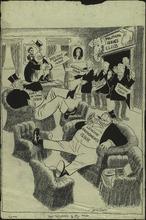
Description: This cartoon depicts many issues leading to political discourse during the late 1910s in the United States. The old sources of political discourse such as "prohibition issue", "he kept us out of war issue", and "tariff issue" have been displaced by the overgrown and overwhelming new issues. The "prohibition issue" refers to the question of whether alcohol should be a legal substance in the United States. The "he kept us out of war issue" refers to the fact that, despite his promise, the United States entered World War I under President Wilson. The "tariff issue" refers to what goods (if any) should have a tariff placed on them to protect the economic interests of the United States. The new issues overtaking the room were a relatively new source of political conflict. The "league amendments issue" refers to the United States entering the League of Nations. If the United States had joined the League of Nations, it would have to surrender some of its national sovereignty, which made it an unacceptable option to many politicians. The "cost of living" was a relatively new issue in the United States. It refers to the unusually high cost of necessary items, while many worker's wages remained low by comparison. The "daylight savings issue" refers to the issue of whether the United States should continue to use daylight savings time. The United States had adopted daylight savings time in 1918. Many countries adopted daylight savings during World War I as a way to lower the need to use coal. The transition to daylight savings time had been problematic, and many in the United States thought it should be abandoned. (Summary created by Mary Delano, MU History Intern, Spring 2018)
Member of: McCutcheon Editorial Cartoons - ALL (Collection)
Resource Type: Still Image
JM-132: Fifty years from now
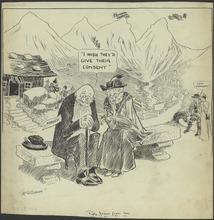
Description: This cartoon depicts an aged version of Katherine Elkins and Prince Luigi Amedeo, Duke of Abruzzi. Katherine Elkins was the daughter of Senator Stephen B. Elkins, an influential politician from West Virginia. The Duke of Abruzzi was Commander in Chief of the Italian fleet and fifth in line for the Italian throne. They met through a series of social events in the United States, and their courtship was covered by the Chicago Tribune and other newspapers for over two years. The Duke of Abruzzi needed the permission from the King of Italy to marry. If the couple had married without royal permission, then Ms. Elkins would not have received a royal title or estates and The Duke of Abruzzi would have received reprimand from the crown. When this cartoon was drawn, the Duke and Ms. Elkins were rumored to be engaged, but still waiting for the King's blessing to wed. Eventually, the King would deny this request and the couple separated around 1912. Katherine Elkins went on to marry Billy Hitt, the son of an Illinois congressman. The Duke Abruzzi led the Italian navy through World War I, and he oversaw the Italian colony of Somalia. The Duke of Abruzzi married as well, and died in 1933. (Summary created by Mary Delano, MU History Intern, Spring 2018)
Member of: McCutcheon Editorial Cartoons - ALL (Collection)
Resource Type: Still Image
JM-158: The President has important business in Massachusetts
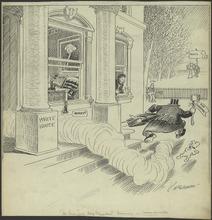
Description: This cartoon shows President Taft racing out of the White House with an ax for his predecessor, Theodore Roosevelt. While President Taft was in office, Theodore Roosevelt continued to remain active in policy. This cartoon was published with article indicating former President Roosevelt sought to protect International Harvester Company, which was in violation of the Sherman Antitrust Act. There had been a series of letter by Theodore Roosevelt published, which indicated Roosevelt was involved with encouraging the government to not pursue International Harvester Company. President Taft was leaving for Massachusetts to give a speech to denounce the actions of Theodore Roosevelt. President Taft also wished to remind the American people how much he had done to eliminate trusts to protect the American people. (Summary created by Mary Delano, MU History Intern, Spring 2018)
Member of: McCutcheon Editorial Cartoons - ALL (Collection)
Resource Type: Still Image
JM-130: Hello, Is that the coroner?
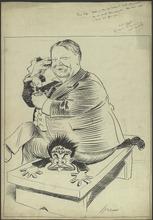
Description: This cartoon is an editorial depiction of the fear of war with Japan in later 1910. At the time, the army of Japan was growing, and they were seeking new technology and funding. This was combined with Japan seizing territory around it, such as parts of Korea. These military actions made relations between the United States and Japan more tense, even to the point where California was proposing legislation to limit the rights of Japanese citizens. The Chicago Tribune took a relatively relaxed approach to the situation, asserting relations between the United States and Japan were nowhere near a declaration of war. Journalists came to this conclusion, because the costs of war were too great for both sides. Ultimately, President Taft sought to avoid public fear by seeking to dismantle rumors of war by publicly announcing the United States intention of peace with Japan. This cartoon shows Taft crushing the personified Japanese war scare while on the phone saying "Hello, is that the coroner? Well, say, come up in about 10 minutes. I'll have a nice job for you." (Summary created by Mary Delano, MU History Intern, Spring 2018)
Member of: McCutcheon Editorial Cartoons - ALL (Collection)
Resource Type: Still Image
JM-136: Adjusting the Russian treaty difficulty

Description: This cartoon illustrates tense diplomatic relations between Russia and the United States in 1911. The Treaty of 1832 between the United States and Russia was created to give citizens of both countries specific rights such as economic freedoms or freedom of movement, whether they resided in Russia or the United States. Slowly beginning in the 1890s and continuing into the 1900s, Russia was limiting the rights of Jewish citizens from the United States. Eventually these citizens' United States passports were no longer accepted by the Russian government, which was clearly against the Treaty of 1832 (or the Treaty of Constantinople). Outraged by this breach, Congress issued the Sulzer Resolution, which called for the immediate nullification of the Treaty of 1832 due to Russia's violation of its contents. The first panel of the cartoon shows the beginning of the political tension between Russia and the United States. Russia was offended by the language of the Sulzer Resolution, stating they never fully violated the treaty. The second panel shows United States resentment of Russia's discrimination of their citizens. The third panel shows the United States compromising with Russia by changing the wording and nuance of the dispute to appeal to Russia's sensibilities. During this political tension, President Taft held a strong desire to maintain diplomatic relations with Russia. Despite Taft's efforts, diplomatic relationships between the United States and Russia remained strained due to a lack of compromise from either side. (Summary created by Mary Delano, History Intern, Spring 2018)
Member of: McCutcheon Editorial Cartoons - ALL (Collection)
Resource Type: Still Image
JM-193: If things only worked out according to the prospectus!
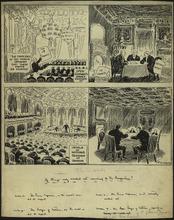
Description: The top left panel is captioned, "The Peace Conference, as the world was led to expect". The caption references Woodrow Wilson presenting his "14 Points" at the Paris Peace Conference in 1919. The Paris Peace Conference was held after the end of fighting in WWI, and resulted in the creation the Treaty of Versailles. The Treaty of Versailles was the document which formally ended WWI, and laid out the terms of surrender for the Axis powers. Wilson's "14 Points" speech outlined his ideas for peace to thrive after such a brutal and catastrophic war. The first point in Wilson's speech is "Open covenants of peace, openly arrived at, after which there shall be no private international understandings of any kind but diplomacy shall proceed always frankly and in the public view". The purpose of this point was to avoid the secret alliances that led to many countries becoming involved in WWI. The top right panel shows Wilson's "14 Points" in the trash and is captioned, "The Peace Conference as it actually worked out". The shows three men signing a secret treaty. Based on their appearances and the context of the cartoon these men are mostly likely President Woodrow Wilson (the left), Prime Minister of France, Georges Clemenceau (the middle), and Prime Minister of England,David Lloyd George (the right). The bottom shows a meeting of the League of Nations, and is captioned "The League of Nations, as the world is led to expect". The League of Nations was Woodrow Wilson's idea to create a body of the world's nations, which would foster international cooperation and support. The League of Nations is the fourteenth point in Wilson's "14 Points" being described as "A general association of nations must be formed under specific covenants for the purpose of affording mutual guarantees of political independence and territorial integrity to great and small states alike".The League of Nations operated from 1920 to 1946, and faced significant problems from nations having varying international interests. The bottom right panel shows five men sitting at a table with the caption, "The League of Nations if it follows the precedent set by the Paris Conference". (Summary created by Mary Delano, MU History Intern, Spring 2018)
Member of: McCutcheon Editorial Cartoons - ALL (Collection)
Resource Type: Still Image
JM-186: Three scenes about labor workers
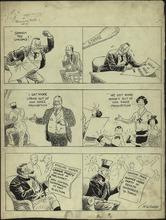
Description: This cartoon depicts three different scenes in separate panels. In the top panel, a business man is angry about workers' unions and wants them to be "smashed," but later, with the threat of a strike hovering over him, he signs his name on a wage increase form. Negotiation between workers and employers were becoming a more common occurrence in the 1910s. Unions and the notion of collective bargaining were beginning to be protected under the law. In the middle panel, a man's boss is happy to get more labor out of the man since prohibition. The man's family also claims to get more money out of him since prohibition, and the children show off their new shoes. This panel shows the desired result of prohibition, which was to eliminate the loss of prosperity and productivity associated with drunkenness.In the bottom panel, John Bull smiles while reading the English paper, which proclaims the growing labor party might control government at next election. Meanwhile, Uncle Sam reads an American paper, which proclaims the Farmer Labor Party has grown to contain three people. As Uncle Sam reads the paper, there is panic in the background. The Farmer Labor Party was a political party founded in 1920 from the larger, international workers' movement associated with communism. As Uncle Sam reads the paper, there is obvious panic in the background. This last panel shows the significant difference in culture between the United States and England. England, like many other European states, was learning to tolerate the labor parties, and it eventually adopted the new parties into their political landscape. The United States was hypersensitive to any hint of communism, due to fears of a workers' revolution. Unlike England, the United States constantly sought to limit the influence and growth of these labor parties as much as possible. This fear is seen by the Red Scare the United States experienced in the 1920s. The Red Scare spread mass fear of communism, and it sought to eliminate communism completely from American economics and culture. (Summary created by Mary Delano, MU History Intern, Spring 2018)
Member of: McCutcheon Editorial Cartoons - ALL (Collection)
Resource Type: Still Image
JM-169: He kept us out of war!
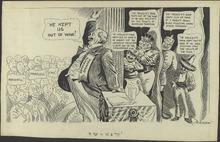
Description: This cartoon shows a democratic speaker addressing a crowd. The speaker is saying, "He kept us out of war", which was President Wilson's campaign slogan for the election of 1916 against Charles Hughes. There are various countries making comments behind the speaker. This first man on the left represents Japan. Japan is saying President Wilson would have gone to war with Japan, if he had allowed an act discriminating against Japanese immigrants in larger immigration legislation.The country next to Japan is England. England is saying that President Wilson would have entered World War I, if he had protected American shipping. This is a reference to the attack of an American ship, the Lusitania, by a German submarine. Japan and England were both Allied powers during World War I, and they are separated from the Axis powers, Germany and Mexico, by a wall. Germany is saying that President Wilson would not have needed to keep the United States out of war, if Germany had not been an aggressor against other nations. Next to Germany, Mexico is saying President Wilson would have declared war, if he had remained adamant on the salute if the flag. This refers to when President Wilson did not want to salute (and thus recognize) the Mexican government under the control of Victoriano Huerta. Despite his apprehension, President Wilson eventually returned the salute from a sense of precedent and duty. (Summary created by Mary Delano, MU History Intern, Spring 2018)
Member of: McCutcheon Editorial Cartoons - ALL (Collection)
Resource Type: Still Image
JM-151: The President is working on his message
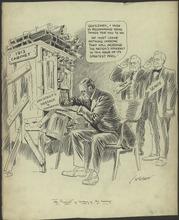
Description: This cartoon shows President Woodrow Wilson drafting his first States of the Union address to Congress. President Wilson was inaugurated on March 4, 1913, and he was the first president from the democratic party to be elected since Grover Cleveland left the office in 1897. President Wilson's desk with ideas he wishes to accomplish while in office. Woodrow Wilson was a leader in the Progressive movement, which proposed society could be improved through legislative reform. President Wilson took office shortly before the beginning of World War I on July 28, 1914. (Summary created by Mary Delano, MU History Intern, Spring 2018)
Member of: McCutcheon Editorial Cartoons - ALL (Collection)
Resource Type: Still Image
JM-183: Cartoonical miscellany
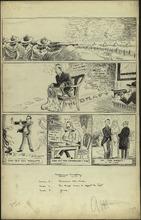
Description: Editorial cartoon depicting three different panels. The top one shows American soldiers fighting against German forces in World War I. The middle panel shows a man sitting in a chair with a horn blast blown by a soldier and the breeze begins to melt the man's frozen feet. The draft refers to the Selective Service Act of 1917, which forced men to enlist for military service. The bottom panel shows May leaving and June entering; a man sits at a desk writing an oration on "How to settle the war"; a man and a woman get married. June is the month in which two of the three registrations for the Selective Service Act of 1917 occurred. Students and married men also were given lower preference to draft in 1917. (Summary created by Mary Delano, MU History Intern, Spring 2018)
Member of: McCutcheon Editorial Cartoons - ALL (Collection)
Resource Type: Still Image
JM-152: Make the punishment fit the crime

Description: Editorial cartoon depicting a congressman proposing that an import duty of a thousand percent be levied on Parisian furniture and works of art, using Ex-Senator Nelson Wilmarth Aldrich as a punchline to talk about the Federal Reserve Act of 1913 that was strongly influenced by the Aldrich–Vreeland Act passed in response to the Knickerbocker Crisis of 1907.
Member of: McCutcheon Editorial Cartoons - ALL (Collection)
Resource Type: Still Image
JM-129: Will It be Conservative or Progressive?
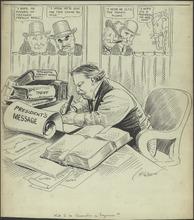
Description: This cartoon depicts President Taft creating a message regarding railroad freight rates. In the 1910, a large portion of goods was transported on railroads in the United States. Railroad owners made large profits by charging rates to ship cargo from one location to another. One of the books in the cartoon is titled, "injunction". This likely refers to the injunction granted by Judge David P. Driver against 25 western railroads located throughout the Midwest to the West Coast, who were all members of the Western Traffic Association. This injunction was granted in Hannibal, Missouri, as a result of an executive order from President Taft. This injunction prevented any of these railroads from raising or adjusting their rates in anyway. The special assistant to the Attorney General, Edwin Grosvenor, presented charges against these railroad companies in St. Louis, Missouri. These charges allegations of price-fixing and conspiracy between these companies to collectively raise rates. President Taft's administration is known for a hard stance against trusts. Taft's predecessor, President Theodore Roosevelt, began this practice during his own administration. Another project begun during President Roosevelt's administration: the construction and governance of the Panama Canal is also shown in this cartoon. (Summary created by Mary Delano, MU History Intern, Spring 2018)
Member of: McCutcheon Editorial Cartoons - ALL (Collection)
Resource Type: Still Image
JM-135: Busy days for the professional stock trader
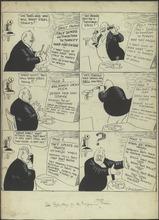
Description: Editorial cartoon depicting a stockbroker trying and failing to predict trends in the stock market.
Member of: McCutcheon Editorial Cartoons - ALL (Collection)
Resource Type: Still Image
JM-185: Tag day

Description: This cartoon depicts two people asking for money. The top panel shows a woman collecting money for the poor and destitute on Tag Day. Tag Day is a day where people will collect money for a charity, and donors will receive a tag showing they donated. The caption for this panel says to remember the children of the poor when being ask the give. The bottom panel shows an officer asking the same man to purchase a liberty loan subscription. These were bonds distributed by the government that were used to support the war effort. In 1917, the United States was a member of the Allied Powers in World War I, which included France, England, Italy, etc. The This panel is captioned, "Don't forget your own children when you are asked to subscribe for Liberty bonds". The man is more skeptical of this purchase than of his donation on Tag Day. (Summary created by Mary Delano, MU History Intern, Spring 2018)
Member of: McCutcheon Editorial Cartoons - ALL (Collection)
Resource Type: Still Image
JM-150: Japanese Haggling
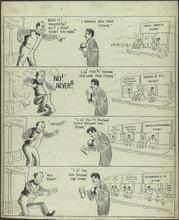
Description: This cartoon depicts a Japanese immigrant attempting to buy property from a white man. As negotiations continue, more Japanese owned stores appear in the background of the the cartoon.Eventually the white man's disposition shifts from enraged to eager as he finally accepts the offer. This cartoon is offering perspective on the relationship between Japanese immigrants and white Americans in the United States, particularly California. The California Alien Land Law of 1913 was passed the same year this cartoon was created.This law prohibited "aliens ineligible for citizenship" from owning agricultural land or possessing long-term leases, but permitted short-term leases lasting up to three years. This law did not have a large tangible impact on Japanese citizens. However, the law remains relevant, because it reflects the discrimination against Japanese immigrants occuring in the 1910s. (Summary created by Mary Delano, MU History Intern, Spring 2018)
Member of: McCutcheon Editorial Cartoons - ALL (Collection)
Resource Type: Still Image
JM-187: Political
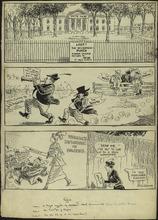
Description: This cartoon depicts various events during the Wilson administration. The top two panels imply a lack of force of the part of President Wilson. After World War I, President Wilson was an outspoken advocate for peace. One of his proposals to accomplish peace was the League of Nations. The League of Nations was an international body, which sought diplomacy and compromise between nations. The United States would never join the League of Nations, because many felt the League would compromise the sovereignty of the United States. The bottom panel of the cartoon shows a woman worrying about meeting the high standards set before her. In 1920, the United States government passed the 19th Amendment, which gave women the right to vote. Women had first found a place in politics by engaging with moral and/or social issues such as education, prohibition, and abolition. By continuing to take a role as protectors of morality women were able to gain enough support to win the right to vote. While the federal government did not allow women to vote in elections until 1920, some states allowed women to vote in state elections. (Summary created by Mary Delano, MU History Intern, Spring 2018)
Member of: McCutcheon Editorial Cartoons - ALL (Collection)
Resource Type: Still Image
JM-138: Well, Gentlemen
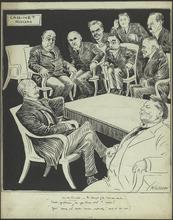
Description: This cartoon depicts Richard Achilles Ballinger, the Secretary of Interior, sweating during a cabinet meeting with President Taft. Ballinger was part of a controversial affair in 1910 that went down in history as either the Pinchot-Ballinger Controversy or the Ballinger Affair. The Ballinger Affair began over an investigation into Clarence Cunningham, who was suspected of illegally transferring land ownership in Alaska to commercial third parties. This investigation began under the Roosevelt administration. Ballinger, the General Land Office Commissioner, eventually concluded the investigation without the approval of his the Secretary of Interior, as he was required. Ballinger left his position for private practice as Cunningham's personal counsel, but he returned to served as Secretary of Interior under President Taft. Ballinger tried to resolve the allegations against Cunningham, but faced great backlash from other members of the administration, including Chief Forester, Gifford Pinchot. Pinchot, among others, accused Ballinger of negligence and endangering public lands. A committee was formed to determine Ballinger's guilt. With the exception of one Republican, all the Republicans on the committee ruled in favor of Ballinger, and all the Democrats on the committee ruled against Ballinger. The Ballinger Affair led to mass criticism of the Taft administration.The dispute between Ballinger and United States Forest Service Chief Gifford Pinchot that contributed to the split of the Republican party before the 1912 presidential election. (Summary created by Mary Delano, MU History Intern, Spring 2018)
Member of: McCutcheon Editorial Cartoons - ALL (Collection)
Resource Type: Still Image
JM-131: Well, I think I am going to have a white Christmas
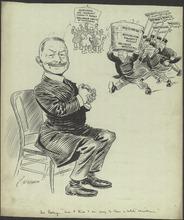
Description: This cartoon depicts Richard Achilles Ballinger, the Secretary of Interior, acting smug over the whitewashed Republican majority report that declares him guiltless while the Democratic insurgent minority report declares him guilty and unfit. Ballinger was part of a controversial affair in 1910 that went down in history as either the Pinchot-Ballinger Controversy or the Ballinger Affair. The Ballinger Affair began over an investigation into Clarence Cunningham, who was suspected of illegally transferring land ownership in Alaska to commercial third parties. This investigation began under the Roosevelt administration. Ballinger, the General Land Office Commissioner, eventually concluded the investigation without the approval of his the Secretary of Interior, as he was required. Ballinger left his position for private practice as Cunningham's personal counsel, but he returned to served as Secretary of Interior under President Taft. Ballinger tried to resolve the allegations against Cunningham, but faced great backlash from other members of the administration, including Chief Forester, Gifford Pinchot. Pinchot, among others, accused Ballinger of negligence and endangering public lands. A committee was formed to determine Ballinger's guilt. With the exception of one Republican, all the Republicans on the committee ruled in favor of Ballinger, and all the Democrats on the committee ruled against Ballinger. The Ballinger Affair led to mass criticism of the Taft administration.The dispute between Ballinger and United States Forest Service Chief Gifford Pinchot that contributed to the split of the Republican party before the 1912 presidential election. (Summary created by Mary Delano, MU History Intern, Spring 2018)
Member of: McCutcheon Editorial Cartoons - ALL (Collection)
Resource Type: Still Image
JM-142: Political methods, old and new
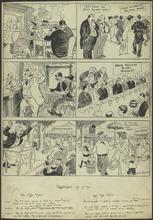
Description: This cartoon illustrates a comparison between "old" and "new" styles of politics in the United States. The men shown in the left panels represent political bosses who sought to influence elections for their own benefit. The people portrayed on the right panels display a more modern approach to politics. This approach included more open and transparent campaigns, and women were allowed to participate in a limited capacity. The political bosses appear confused at this new way of engaging politics. The "old way" of politics shows the bosses holding primary elections only amongst themselves, buying drinks for other men, and consuming excessive amounts of alcohol. The "new way" of politics shows men and women enjoying parties, banquets, and picnics in a family-friendly environment. The political bosses are shocked and confused to see how politics has changed overtime. The shift in politics occurred as women became more involved with political initiatives such as abolition or prohibition. (Summary created by Mary Delano, MU History Intern, Spring 2018)
Member of: McCutcheon Editorial Cartoons - ALL (Collection)
Resource Type: Still Image
JM-189: Compromises
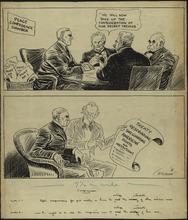
Description: The top panel of this cartoon depicts President Woodrow Wilson meeting with other world leaders at the Paris Peace Conference in 1919. The Paris Peace Conference began after the armistice agreement for World War I, and it eventually produced the Treaty of Versailles. The four men meeting depict the leaders of the "Big Four" Allied powers of WWI. The Big Four nations were the United States, led by President Woodrow Wilson, England, led by Prime Minister David Lloyd, France, led by Prime Minister Georges Clemenceau, and Italy, led by Prime Minister Vittorio Orlando. These men are creating secret treaties, which is in contradiction with Wilson's "14 Points" speech. The first point in this speech is "Open covenants of peace, openly arrived at, after which there shall be no private international understandings of any kind but diplomacy shall proceed always frankly and in the public view". This point was created to address the practice of secret treaties between nations, which many contributed to the beginning of World War I. The 14 points are conspicuously placed in the garbage at this meeting. The bottom panel depicts Uncle Sam showing Woodrow Wilson ways to protect the United States while signing treaties with other nations. This panel is captioned, "he ought to be able to compromise now to satisfy the interests of his own". This caption is used to suggest there may have been conflict between President Wilson's interests and the interests of the United States. (Summary created by Mary Delano, MU History Intern, Spring 2018)
Member of: McCutcheon Editorial Cartoons - ALL (Collection)
Resource Type: Still Image
JM-182: The new income tax
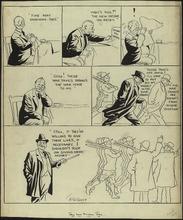
Description: This cartoon depicts a man being irritated with the high income tax rates in the United States. The man suggests the reason for the increased taxes is the fact the the United States is currently fighting in World War I. The man continues to complain about the income tax until he passes a group of soldiers. The man realizes his financial sacrifice is less than that being made by the men serving in the military. (Summary created by Mary Delano, MU History Intern, Spring 2018)
Member of: McCutcheon Editorial Cartoons - ALL (Collection)
Resource Type: Still Image
JM-021: Mr. American reactionary abroad tries to change the opinion of Europe

Description: Editorial cartoon depicting an American visiting places such as France, Germany, and Italy and hearing praise for Roosevelt, which the American does not agree with.
Member of: McCutcheon Editorial Cartoons - ALL (Collection)
Resource Type: Still Image
JM-065: Our present divorce laws
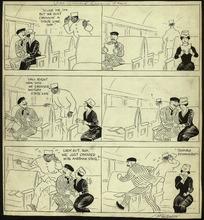
Description: Editorial cartoon depicting a couple being warned by a train worker and moving to sit together or apart depending on what state the train is passing through.
Member of: McCutcheon Editorial Cartoons - ALL (Collection)
Resource Type: Still Image
Pagination
- Page 1
- Next page